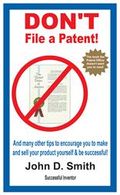
The book is directed toward individual inventors and small companies with little or no budget for intellectual property or litigation. Although the book takes an overly-extreme position, Smith suggests the valid argument that the limited resources of a small entity is often better spent on other business development activities. His "Reason #5 not to file a patent" explains this point:
The patent process costs tens of thousands of dollars. This is a waste of your money. A better investment is making your product first in the mind of your customer. . . . Back in 2005 when I filed my original patent application, I didn't have all this knowledge. At the time, some attorneys suggested that inventors "should wait and not market your product until you have a patent." I'm glad I never listened to that advice. Good thing I started marketing Storm Stoppers right away! Had I waited until getting a patent, I'd have nothing now. No awesome name brand, no millions of dollars in past sales, no thousands of customers, no appearances on CNBC & CNN, no Goodwill donation trips to the Bahamas and no learning and improving my product. Marketing your product right away is the only way to demonstrate that you have a good product.
About one-half of the book is dedicated to explaining why patenting is a waste of time and money for folks in his situation. The other half is devoted to providing some guidance on marketing and manufacturing.
At times throughout the book, Mr. Smith appears so burned by his past experience that he is blinded to the potential that patents can add in certain situations. With that major caveat, I think that the book is a good read and could be a useful tool for containing over-exuberance of innovators.
-
John Smith's Website (Where you can buy the book)
-
Patent Holder and Satirist Gary Odom Discusses the book here.
-
Patrick Anderson discusses the book on his blog Gametime IP.